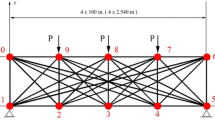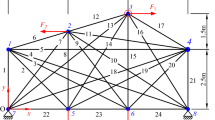Abstract
This paper discusses the effect of global stability on the optimal size and shape of truss structures taking into account of a nonlinear critical load, truss weight and serviceability at the same time. The nonlinear critical load is computed by arc-length method. In order to increase the accuracy of the estimation of critical load (ignoring material nonlinearity), an eigenvalue analysis is implemented into the arc-length method. Furthermore, a pure pareto-ranking based multi-objective optimization model is employed for the design optimization of the truss structure with multiple objectives. The computational performance of the optimization model is increased by implementing an island model into its evolutionary search mechanism. The proposed design optimization approach is applied for both size and shape optimization of real world trusses including 101, 224 and 444 bars and successful in generating feasible designations in a large and complex design space. It is observed that the computational performance of pareto-ranking based island model is better than the pure pareto-ranking based model. Therefore, pareto-ranking based island model is recommended to optimize the design of truss structure possessing geometric nonlinearity.



















Similar content being viewed by others
References
Cantu-Paz E 1999 Migration policies and takeover times in parallel Genetic Algorithms. Int. Conf. on Genetic and Evolutionary Computation 775–779
Cardoso J B and Arora J S 1988 Variational method for design sensitivity analysis in nonlinear structural mechanics. AIAA J. 26: 5–22
Choi K K and Santos J L T 1987 Design sensitivity analysis of nonlinear structural systems, Part I: theory. Int. J. Numer. Meth. Eng. 24: 2039–2055
Crisfield M A 1997 Nonlinear finite element analysis of solids and structures, Vol. 2 Advanced topics. UK: John Wiley & Sons
Eby D, Averill R, Goodman E and Punch W 1999 The optimization of flywheels using an injection island genetic algorithm. Evol. Design Computers 167–190
Gien H 2007 Geometrically nonlinear static analysis of 3D trusses using the arc-length method. 13th Int. Conf. on Comp. Methods and Experimental Meas. Prague, Czech Republic
Goldberg D E and Richardson J 1987 Genetic algorithms with sharing for multimodal function optimization. Genetic algorithms and their applications, 2nd Int. Conf. on Genetic Algor. and Their Appl. Massachusetts, USA, 41–49
Hasancebi O and Erbatur F 2002 Layout optimization of trusses using simulated annealing. Advance Eng. Soft. 33: 681–696
Kamat M P, Khot N S and Venkayya V B 1984 Optimization of shallow trusses against limit point instability. AIAA J. 22: 403–408
Khot N S and Kamat M P 1985 Minimum weight design of truss structures with geometric nonlinear behavior. AIAA J. 23: 139–144
Khot N S, Venkayya V B and Berke L 1976 Optimum structural design with stability constraints. Int. J. Num. Meth. Eng. 10: 1097–1114
Kouhia R and Mikkola M 1999 Some aspects of efficient path-following. Comput. and Struct. 72: 509–524
Krenk S 1995 An orthogonal residual procedure for nonlinear finite element equations. Int. J. Numer. Meth. Eng. 38(5): 823–839
Lamberti L and Pappalettere C 2004 Improved sequential linear programming formulation for structural weight minimization. Comput. Methods Appl. Mech. Eng. 193: 3493–3521
Levy R 1994a Optimization for buckling with exact geometries. Comput. and Struct. 53: 1139–1144
Levy R 1994b Optimal design of trusses for overall stability. Comput. and Struct. 53(5): 1133–1138
Levy R and Perng H S 1988 Optimization for nonlinear stability. Comput. and Struct. 30: 529–535
Levy R, Su M and Kocvara M 2004 On the modeling and solving of the truss design problem with global stability constraints. Struc. Multidisc. Opt. 26: 367–378
Lin C C and Liu I W 1989 Optimal design based on optimality criterion for frame structures including buckling constraints. Comput. and Struct. 31(4): 535–544
Magnusson A 2006 Treatment of bifurcation points with asymptotic expansion. Comput. and Struct. 77: 475–484
Malott B, Averill R C, Goodman E D, Ding Y and Punch W F 1996 Use of genetic algorithms for optimal design of laminated composite sandwich panels with bending-twisting coupling. 37th Int. Conf. of Struc. Dyn and Mat. AIAA/ASME/ASCE/AHC/ASC. Utah, USA
Memon B A and Su X 2004 Arc-length technique for nonlinear finite element analysis. J. Zhejiang Univ. Science 5(5): 618–628
Ohsaki M 2001 Sensitivity analysis and optimization corresponding to a degenerate critical point. Int. J. Solids Struct. 38: 4955–4967
Ohsaki M 2005 Design sensitivity analysis and optimization for nonlinear buckling of finite-dimensional elastic conservative structures. Comp. Meth. Appl. Mech. Eng. 194: 3331–3358
Ohsaki M and Ikeda K 2006 Imperfection sensitivity analysis of hill-top branching with many symmetric bifurcation points. Int. J. Solids Struct. 43(16): 4704–4719
Ortiz T A and Walls R H 2003 Wtest: test for homogeneity of variances. http://www.mathworks.com/matlabcentral/fileexchange/
Plaut R H, Ruangsilasingha P and Kamat M P 1984 Optimization of an asymmetric two-bar truss against instability. J. Struct. Mech. 12(4): 465–470
Polheim H 1998 Genetic and evolutionary algorithm toolbox for use with MATLAB. Technical Report. Technical University Ilmnau
Rezaiee-Rojand M and Vejdari-Nogreiyan H R 2006 Computation of multiple bifurcation points. Int. J. Computer-aided Eng. Soft. 23(5): 552–565
Ritto-Correa M and Camotim D 2008 On the Arc-length and other quadratic control methods: Established, less known and new implementation procedures. Comput. and Struct. 86: 1353–1368
Santos J L T and Choi K K 1988 Sizing design sensitivity analysis of nonlinear structural systems, Part II. Int. J. Numer. Meth. Eng. 26: 2039–2055
Schlierkamp-Voosen D and Mühlenbein H 1996 Adaptation of population sizes by competing subpopulations. Int. Conf. on Evolutionary Computation IEEE 330–335
Sedaghati R and Tabarrok B 2000 Optimum design of truss structures undergoing large deflections subject to a system stability constraint. Int. J. Numer. Meth. Eng. 48(3): 421–434
Talaslioglu T 2010 Multiobjective design optimization of grillage systems by scatter search methodology. Int. J. Civil Struc. Eng. 1(3): 477–496
Veldhuizen D V and Lamont G B 1998 Multi-objective evolutionary algorithm research: a history and analysis. Technical Report TR-98-03. Ohio, USA: Department of Electrical and Computer Engineering, Air Force Institute of Technology
Wrigger P, Wagner W and Miehe C 1988 Quadratically convergent procedure for the calculation of stability points in finite elements. Comp. Meth. Appl. Mech. 70: 329–347
Author information
Authors and Affiliations
Corresponding author
Appendices
Appendix A. Computation of nodal coordinates.
Node number | Matlab expressions used to compute nodal coordinates of arc structure with 101 bar | |
|---|---|---|
X Coordinate | Y Coordinate | |
1 | −(R1*sin(pi*(45-alpha1)/180)) | (R1*cos(pi*(45-alpha1)/180)) |
2 | −((R1+a1)*sin(pi*(45-alpha1)/180)) | ((R1+a1)*cos(pi*(45-alpha1)/180)) |
3 | −(R2*sin(pi*(45-alpha2)/180)) | (R2*cos(pi*(45-alpha2)/180)) |
4 | −((R2+a2)*sin(pi*(45-alpha2)/180)) | ((R2+a2)*cos(pi*(45-alpha2)/180)) |
5 | −(R3*sin(pi*(45-alpha3)/180)) | (R3*cos(pi*(45-alpha3)/180)) |
6 | −((R3+a3)*sin(pi*(45-alpha3)/180)) | ((R3+a3)*cos(pi*(45-alpha3)/180)) |
7 | −(R4*sin(pi*(45-alpha4)/180)) | (R4*cos(pi*(45-alpha4)/180)) |
8 | −((R4+a4)*sin(pi*(45-alpha4)/180)) | ((R4+a4)*cos(pi*(45-alpha4)/180)) |
9 | −(R5*sin(pi*(45-alpha5)/180)) | (R5*cos(pi*(45-alpha5)/180)) |
10 | −((R5+a5)*sin(pi*(45-alpha5)/180)) | ((R5+a5)*cos(pi*(45-alpha5)/180)) |
11 | −(R6*sin(pi*(45-alpha6)/180)) | (R6*cos(pi*(45-alpha6)/180)) |
12 | −((R6+a6)*sin(pi*(45-alpha6)/180)) | ((R6+a6)*cos(pi*(45-alpha6)/180)) |
13 | −(R7*sin(pi*(45-alpha7)/180)) | (R7*cos(pi*(45-alpha7)/180)) |
14 | −((R7+a7)*sin(pi*(45-alpha7)/180)) | ((R7+a7)*cos(pi*(45-alpha7)/180)) |
15 | −(R8*sin(pi*(45-alpha8)/180)) | (R8*cos(pi*(45-alpha8)/180)) |
16 | −((R8+a8)*sin(pi*(45-alpha8)/180)) | ((R8+a8)*cos(pi*(45-alpha8)/180)) |
17 | −(R9*sin(pi*(45-alpha9)/180)) | (R9*cos(pi*(45-alpha9)/180)) |
18 | −((R9+a9)*sin(pi*(45-alpha9)/180)) | ((R9+a9)*cos(pi*(45-alpha9)/180)) |
19 | −(R10*sin(pi*(45-alpha10)/180)) | (R10*cos(pi*(45-alpha10)/180)) |
20 | −((R10+a10)*sin(pi*(45-alpha10)/180)) | ((R10+a10)*cos(pi*(45-alpha10)/180)) |
21 | 0 | R11 |
22 | 0 | (R11+a11) |
Nomenclature
- p ext :
-
External joint load
- P :
-
Load increment used for incremental stage
- p int :
-
Internal force
- R :
-
Residual force
- δ1 :
-
Displacement increment computed in the end of iteration process (beginning point of incremental stage or first end of arc-length)
- δ2:
-
Displacement increment computed by external load (in incremental stage)
- δ3:
-
Sub-displacement computed in incremental stage but updated in iterative stage
- δ4:
-
Sub-displacement computed using residual force r (in iterative stage)
- δ5:
-
Sub-displacement increment for iterative stage
- β :
-
Scaling factor
- β1:
-
Sub-scaling factor used to update β computed in iterative stage
- ε :
-
Desired convergence degree
- inc_max :
-
Maximum number of increments
- it_max :
-
Maximum number of iterations
- K :
-
System stiffness matrix
- det[K] :
-
Determinant of stiffness matrix
- L :
-
Limit Load
- W :
-
Weight of truss structure
- δ :
-
Deflection
- x,y,z :
-
Coordinates of nodes
- P :
-
Material density
- Nda :
-
Number of different cross-sectional areas
- Nn :
-
Number of nodes
- Ntm :
-
Number of truss member
Rights and permissions
About this article
Cite this article
TALASLIOGLU, T. Global stability-based design optimization of truss structures using multiple objectives. Sadhana 38, 37–68 (2013). https://doi.org/10.1007/s12046-013-0111-y
Received:
Revised:
Accepted:
Published:
Issue Date:
DOI: https://doi.org/10.1007/s12046-013-0111-y




